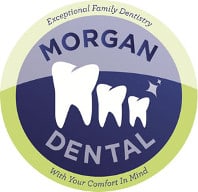What are bleaching trays?
Bleaching trays are plastic retainers made using models of your teeth that hold whitening (bleach) gel. Each tray is custom-made to fit over the user’s upper and lower teeth “like a glove.” To perform treatments, the user places whitening gel in the trays and then seats them over their teeth according to the whitening gel manufacturer’s instructions.
Who may benefit from teeth whitening (bleaching)?
Almost anyone can benefit. However, teeth whitening treatment may not be as effective for some as it is for others. Artificial teeth, caps, crowns, veneers, and existing dental fillings will not whiten so those with these in the “smile line” will likely have uneven results. Teeth with multiple colorations, bands, splotches or spots due to tetracycline use or fluorosis do not whiten as well. Dr. Morgan can determine if you are a viable candidate for this procedure as part of a thorough oral exam, including a shade assessment.
How long do the results last?
By following some simple post whitening care instructions, your teeth will always be lighter than they were before. To keep your teeth looking their best, we recommend flossing, brushing twice daily, professional dental cleanings, and occasional whitening touch-ups with your bleaching trays and teeth whitening agent such as DayWhite.
Is whitening safe?
Yes. Extensive research and clinical studies indicate that whitening teeth under the supervision of a dentist is safe. In fact, many dentists consider whitening the safest cosmetic dental procedure available.
Are there any side effects?
Sensitivity during the treatment may occur with some patients. Using a sensitivity toothpaste or prescription strength fluoride prior to and after treatment will help or eliminate this sensitivity. Examples: Plain baking soda and water (least abrasive choice), Colgate Regular, Sensodyne, Crest Regular, Biotene Regular, Aquafresh Sensitive, Pronamel, and Arm & Hammer Peroxicare Regular.
What causes tooth discoloration?
There are many causes. The most common include aging and consumption of staining substances such as coffee, tea, colas, tobacco, red wine, etc. During tooth formation, consumption of tetracycline, certain antibiotics or excessive fluoride may also cause tooth discoloration.
